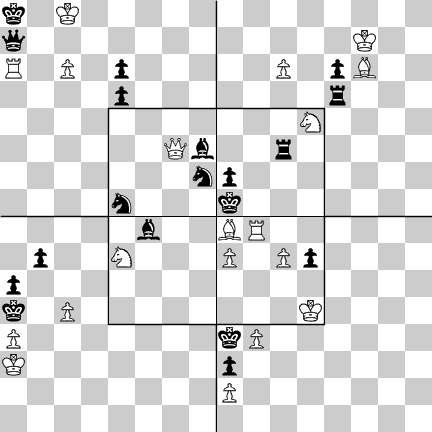Nuova Rivista degli Scacchi, 1879
bizzarria scacchistica) (3 pr.)
H. Leprettel= H. Pelletret (Salve regina)
In the Sep. issue, 1879, the notice of L. Centurini's
donation of
additional prizes was repeated, previously published on the cover
of the August issue. Correct single problems of faulty sets would
compete for these prizes.
In the same issue, it was stated that only one set would be allowed per
competitor. Any superfluous sets already sent in were recommended to
be withdrawn. Additionally, the closing date was postponed by two months.
The judge's report said that the number of direct mate problems were 52, eight of which were withdrawn. Of the
remainder 27 were defect. Four sets were disqualified due to
having been already published, which the tourney management
to some extent appear to have treated as a joke rather than deliberate plagiarism. 13 sets remained.
(The set Salve Regina appear to have been demolished due to
a printing error; it was later re-admitted to competition.)
As regards the excentric sets, 23 were received, three were withdrawn,
and one disqualified for an incomprehensible solution. The judge
noted the difficulty of judging excentric chess problems where
no common rules for evaluation are present, and
based his judgement on beauty and originality of idea, and also
on the difficulty the author had to overcome.
The judge's report originally awarded the special prizes to #3 of Sanctus
Sylvester and #4 of Es gedeihe das Schach allüberall.
The final report identified this as a mistake: the
awards should have been reversed: #4 of Sanctus
Sylvester and #3 of Es gedeihe ... .
Additionally, the final report noted that one of the sets given
an honorary mention by the judge
had turned out to be faulty, and so awarded the hm. to the set Es gedeihe ... instead.
The final report omitted the name of the composer of Es gedeihe ...: a footnote explained that the competitor had requested to withdraw
the set from competition, as well as keep his identity secret. This request had arrived when the report was
already set up to be printed, suggesting that the request was not
rejected outright. The date of the request was not
published: it is not known if it was made before the judge's report
was printed, or after.
In the following issue, the request for secrecy was noted to be
more or less useless as German newspapers had already revealed that
the competitor was J. Berger of Graz. (These sources are so far unknown.)
The Nuova Rivista added that J. Berger had refused
to accept the prize for the #3.
No reason for the withdrawal
appear to have been published, or can easily be inferred from the
printed criticism of the two problems.
The first prize problem of the Bizzarria
section was published
with extensive notes on how moves on one board (say, the center board), would affect the other boards. No attempt at a summary of the stipulation
can make full justice to this discussion: the interested
solver is recommended to use the original source as cited with the diagram.
No complete solution appears to have been
published, which makes it difficult to verify the problem.
The only known solution is the key move and the board it is made on. (See Nuova Rivista degli Scacchi, v5/8 (Sep.-Oct., 1880), p. 249. No errata has been noted so far.)
Prizes
A: Direct mates
1 Prize: A. Kauders
2 Prize: G. B. Valle
3 Prize: D. Melissinos
Prize best #3: J. Berger
1
#3
Prize best #4: A. Kauders
2
#4
B: Excentric problems
1 Prize: G. B. Vallee
2
3
 1
5 = center board
4
1
5 = center board
4
White moves and mates. The key move
is made on one of the five 8x8 board of the full 16x16 board and affects all boards that share the corresponding squares, after which the individual
8x8 boards are solved individually [ ? : see notes! ]
2 Prize: C. Chocholous
White's position is correct, and has been reached with only one capture: gxh3. Black's position is partially incorrect. Correct, and mate in one.
3 Prize: J. Jespersen
#2. Who has the move?
1
#3
2
#4
1 Prize: G. B. Vallee

White moves and mates. The key move is made on one of the five 8x8 board of the full 16x16 board and affects all boards that share the corresponding squares, after which the individual 8x8 boards are solved individually [ ? : see notes! ]
2 Prize: C. Chocholous
White's position is correct, and has been reached with only one capture: gxh3. Black's position is partially incorrect. Correct, and mate in one.
3 Prize: J. Jespersen
#2. Who has the move?